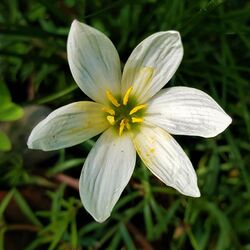Biology:Zephyranthes candida
| Zephyranthes candida | |
|---|---|

| |
| Scientific classification | |
| Kingdom: | Plantae |
| Clade: | Tracheophytes |
| Clade: | Angiosperms |
| Clade: | Monocots |
| Order: | Asparagales |
| Family: | Amaryllidaceae |
| Subfamily: | Amaryllidoideae |
| Genus: | Zephyranthes |
| Species: | Z. candida
|
| Binomial name | |
| Zephyranthes candida (Lindl.) Herb.
| |
| Synonyms[1] | |
| |
Zephyranthes candida, with common names that include autumn zephyrlily,[2] white windflower,[3] white rain lily,[4] and Peruvian swamp lily,[5] is a species of rain lily native to South America including Argentina , Uruguay, Paraguay, and Brazil . The species is widely cultivated as an ornamental and reportedly naturalized in many places (South Africa , the Indian subcontinent, Zimbabwe, Seychelles, central and southern China , Korea, Nansei-shoto (Ryukyu Islands), Bhutan, Solomon Islands, Queensland, Nauru, Tonga, Society Islands, Mariana Islands, southeastern United States (from Texas to North Carolina), the Lesser Antilles, and Peru).[6][7]
Leaves are a deep glossy green and measure 3 mm wide. Flowers, which bud late in August (when propagated in the Northern Hemisphere) at first resemble a new leaf, but emerge from their papery sheaves to a stunning whiteness; they are erect in perianth white and sometimes pinkish abaxially. The leaf-like bract is 1.8 to 4 cm. They grow best in full sun to part shade and require a medium wet soil. Propagation is done by dividing bulbs or offsets and from seed.[8][9][10][11]
Zephyranthes candida was first described by John Lindley in 1823 as Amaryllis candida.[9] It was transferred to its current genus in 1826 by William Herbert.[8][3] Other common names of Zephyranthes candida include August rain lily, white zephyr lily, white fairy lily, white rain lily, and autumn zephyr lily.[citation needed]
Cultivation
Hardiness: USDA zones 7-10.[citation needed]
Chemical constituents
It contains lycorine, nerinine, haemanthamine, tazettine, haemanthidine, zephyranthine.[12]
See also
- List of plants known as lily
References
- ↑ The Plant List
- ↑ "Zephyranthes candida". Natural Resources Conservation Service PLANTS Database. USDA. https://plants.usda.gov/core/profile?symbol=ZECA.
- ↑ 3.0 3.1 "Zephyranthes candida". Australian Plant Name Index (APNI), IBIS database. Centre for Plant Biodiversity Research, Australian Government. http://www.anbg.gov.au/cgi-bin/apni?taxon_id=44569.
- ↑ {{citation | mode = cs1 | title = Zephyranthes candida | work = Germplasm Resources Information Network (GRIN) | url = | publisher = [[Organization:Agricultural Research ServAgricultural Research Service (ARS), United States Department of Agriculture (USDA) | access-date = }}
- ↑ "Royal Horticultural Society: Find a Plant". https://www.rhs.org.uk/Plants/19213/Zephyranthes-candida/Details.
- ↑ Kew World Checklist of Selected Plant Families
- ↑ Biota of North American Program
- ↑ 8.0 8.1 Herbert, William. 1826. Botanical Magazine 53: pl. 2607, Zephyranthes candida
- ↑ 9.0 9.1 Lindley, John. 1823. Botanical Register 9: pl. 724, Amaryllis candida
- ↑ Sasaki, Shun-ichi. 1928. List of Plants of Formosa 112, as Atamosco candida
- ↑ Rafinesque, Constantine Samuel. 1838. Flora Telluriana 4: 10. as Plectronema candida
- ↑ "Katoch D and Singh B, Med Aromat Plants". https://www.longdom.org/open-access/phytochemistry-and-pharmacology-of-genus-zephyranthes-2167-0412-1000212.pdf.
External links
Wikidata ☰ Q3240203 entry
 |

